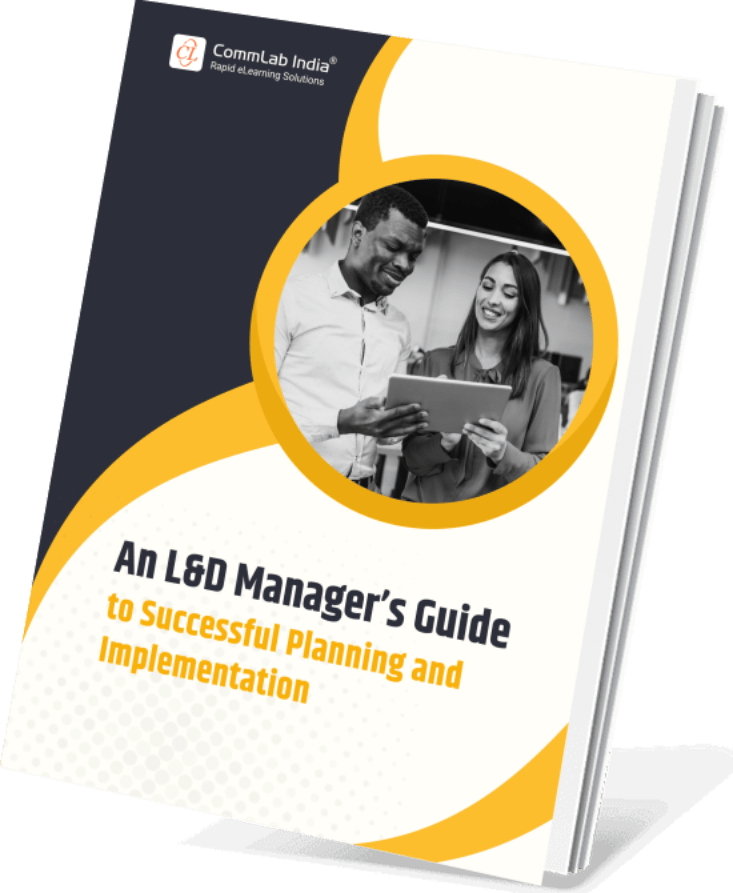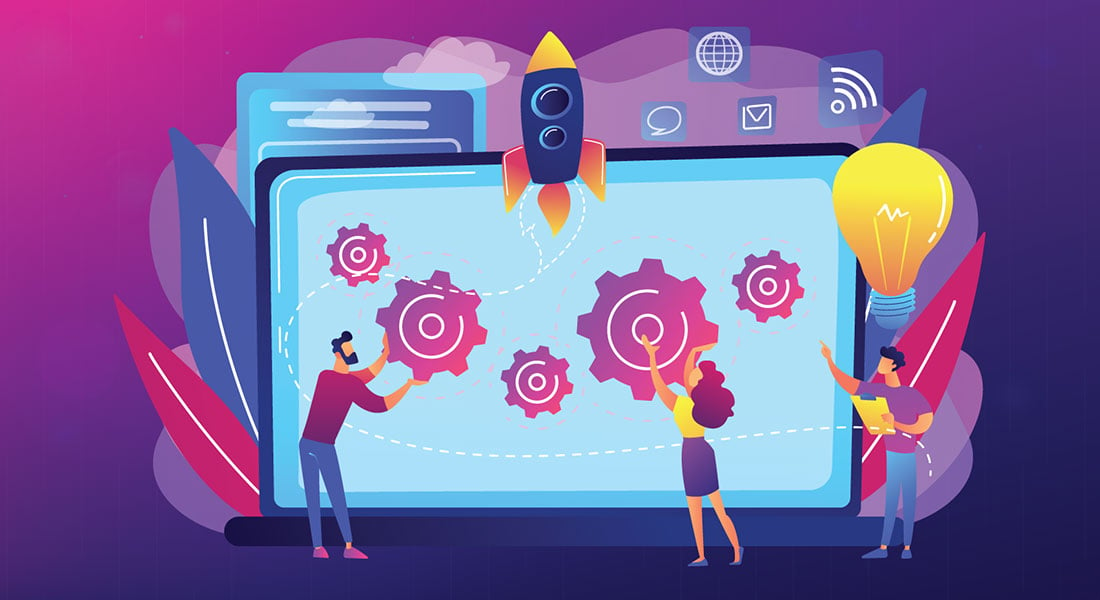How to Design and Develop Impactful Learning Solutions: Tips for L&D Managers

Imagine this: Your employees are bored in training sessions, struggling to retain information, and your organization's bottom line shows no improvement from your L&D efforts. Sound familiar? In today's dynamic business landscape, rote "training" just doesn't cut it anymore.
L&D rockstars know the importance of crafting strategic learning solutions that drive measurable results and empower their workforce. This blog dives into practical tips to help you navigate the learning design and development process, ensuring your learning and development (L&D) initiatives go from training chaos to impactful learning experiences that deliver real training ROI.
→ Download eBook: An L&D Manager's Guide to Successful Planning & Implementation.
Table of Content
How to Design and Develop Impactful Learning Solutions: Tips for L&D Managers
- Partner with Subject Matter Experts (SMEs)
- Leverage the 70/20/10 Model
- Taking Stock of Existing Learning Solutions and Performance Materials
- Plan for Refresher Training and Multilingual Needs
- Content Analysis and Selecting the Right Modality
- Project Planning for Success
- Developing the Design Documents
- Developing the Learning Solutions
- Develop ILT/VILT Materials
- Getting Ready for Launch and Progressive Rollout
- Implement a Progressive Rollout
Crafting Impactful L&D Experiences on a Budget? Here's How:
- Repurpose Existing Content: Don't reinvent the wheel! Analyze existing learning materials and identify opportunities for refresh or repurposing.
- Embrace Free & Freemium Tools: Explore free and freemium authoring tools for eLearning development. Consider open-source platforms for LMS needs.
- Leverage SME Expertise: SMEs are a goldmine of knowledge. Utilize their insights to curate high-quality content without additional content creation costs.
- Focus on Microlearning & Blended Learning: Break down complex topics into bite-sized modules for better engagement. Combine online and offline elements for a well-rounded learning experience.
- Prioritize Measurable Outcomes: Focus on tracking key metrics (skills improvement, task performance) to demonstrate the impact of your learning initiatives.
How to Design and Develop Impactful Learning Solutions: Tips for L&D Managers
1. Partner with Subject Matter Experts (SMEs)
The design phase kicks off with a crucial step: collaborating with SMEs. These subject matter experts are the cornerstone of your content's accuracy and relevance. Walk them through your L&D vision and the learning roadmaps. This helps everyone understand the bigger picture and minimizes redundancy in their input.
2. Leverage the 70/20/10 Model
As an L&D architect, your focus goes beyond formal training. The 70/20/10 model highlights the importance of incorporating experiential learning (70%) and social learning (20%) alongside formal training (10%). Leverage SME interviews to uncover existing informal learning opportunities within your organization, like communities of practice. Integrate these elements into a cohesive learning strategy, offering learners various avenues to gain knowledge and refine skills.

3. Taking Stock of Existing Learning Solutions and Performance Materials
While gathering content for new training initiatives, don't overlook existing learning materials. Document and analyze them in light of your current learning goals. This is an opportunity to identify outdated materials that need refreshing or shelving. Additionally, during SME interviews, gather inputs for follow-up activities and job aids. These resources will provide ongoing support to learners at their point of need.
4. Plan for Refresher Training and Multilingual Needs
Refresher and reinforcement training shouldn't be an afterthought. Plan for ongoing activities to solidify key learning areas in your project. Similarly, identify if your deliverables require translation during SME interviews. Document these needs and factor them into project plans to ensure a smooth rollout for multilingual learners.
5. Content Analysis and Selecting the Right Modality
Once you have the SMEs' inputs, the design process kicks in with content analysis. This involves instructional designers dissecting the content, clarifying learning objectives, and ensuring alignment with your overall L&D goals. Discuss assessment strategies with SMEs during this phase.

An L&D Manager's Guide to Successful Planning & Implementation.
Learn:
- What Challenges do L&D Managers Face?
- How to Align Business and Project?
- How to be a Learning Consultancy?
- DOWNLOAD NOW!
6. Project Planning for Success
With the modality and duration of your learning solutions decided, it's time for the project manager to create detailed plans. These plans should include milestones and touchpoints for SME review and sign-offs. A well-structured project plan minimizes surprises and keeps scope creep in check.
7. Developing the Design Documents
Following project plan approval, your team will develop interim design deliverables. These might include design documents (for complex topics), detailed content outlines, and storyboards. The specifics will naturally depend on the chosen learning modality (eLearning, instructor-led, etc.).
8. Developing the Learning Solutions
With design sign-offs secured, we move into development, utilizing agile methodologies for building functional learning materials. Take advantage of existing eLearning templates, libraries, and outlines for efficiency. For video elements, explore AI-powered tools like Vyond or Synthesia to create the desired course aesthetic. Interactive PDFs can be built with InDesign, while graphics creation can leverage AI tools like Canva alongside traditional methods.
Is Synthesia a MUST-TRY for Rapid eLearning? [VIDEO]
9. Develop ILT/VILT Materials
For instructor-led or virtual instructor-led (ILT/VILT) training materials, typical deliverables include a PowerPoint deck, facilitator guides, and participant guides. Remember to factor in the chosen VILT platform and how interactions like breakout rooms will be facilitated. Detailed instructions for both facilitators and learners ensure a smooth learning experience. Don't forget to incorporate interactive elements like polls to keep learners engaged.

10. Getting Ready for Launch and Progressive Rollout
Once all approvals and sign-offs are in place, it's time to prepare your learning solutions for launch. For eLearning, this involves publishing and packaging them into SCORM packages for upload to your Learning Management System (LMS) after rigorous testing.
11. Implement a Progressive Rollout
Especially for longer learning journeys or blended learning programs, implementing a progressive rollout with scheduled feedback opportunities is crucial. Gather learner and manager feedback at regular intervals (quarterly, bi-monthly) to gauge the impact of your training. This valuable feedback allows for continuous improvement and ensures your learning solutions remain relevant and effective. Don't just train your workforce, empower them! By following these design and development best practices, you can create impactful learning experiences that drive measurable results, boost employee engagement, and propel your organization forward.
Wrapping Up
This blog has provided a foundational framework for L&D managers navigating the design and development process. Remember, designing impactful learning solutions requires careful planning, collaboration, and a focus on aligning content with both organizational goals and learner needs. But it doesn't stop there! The true mark of a successful L&D professional lies in their ability to measure the impact of their initiatives.
Download our free eBook: "An L&D Manager's Guide to Successful Planning & Implementation" to delve deeper into establishing measurable goals, selecting the right evaluation methods, and demonstrating the ROI (return on investment) of your learning solutions.





